Fibre installations
Fibre optic cable types are optical multimode (OM) or optical single mode (OS). You’ll typically see numbers on the actual cable after either the OM or the OS marks, which specify the different data rates the cable will run, in addition to the wavelength, distance and attenuation specifications.
Fibre optic is ideal for use in large sites and campuses with multiple buildings, and in large buildings with multiple cabinets and is used for linking these multiple cabinets together. The reason for a site to use multiple cabinets is to ensure that the length of all copper (cat5,6) cables used for endpoints is kept under the recommended length, usually 90 metres. Copper links between cabinets can be used but do not support the same speeds as fibre hence why we use fibre for any long distance links which are generally termed as a networks ‘back bone’. Fibre cables are less robust than copper cable and therefore require more care in their handling during installation.
Optical Multimode Fibre / OM
The fibre optic cables are divided into the following categories:
- OM1 – the most basic of the fibre optic cables, best suited to be installed for distances of 275 metres for gigabit data.
- OM2 – best suited for distances of up to 550 metres and will support gigabit data traffic.
- OM3 – best suited for 10 gigabit data for up to 300 metres. This is typically used as the most basic for voice, data, CCTV, video or other modern requirements.
- OM4 – suited for 10 gigabit transmission for up to 550 metres of distance.
What’s the difference between OM3 and OM4?
OM4 fibre became available in 2005, basically as a souped-up version of the already pretty good OM3 fibre. The big deal with OM4 is that it brings some clarity for buyers since all manufacturers use the same name. So, you know what you’re getting.
Although OM4 looks just like OM3 with its aqua jacket, it’s got some serious upgrades. It’s tailored for VSCEL laser tech, which means it can handle data flying around at up to 10 Gigabits per second. Plus, it can do this over longer distances – 550 meters compared to the 300 meters of OM3.
One of the best things about OM4 is its bandwidth. Basically, it can handle far more data at once compared to OM3. OM4’s got more than double the bandwidth, making it perfect for tasks that need super-fast data transfer.
OM3 fibre is still suitable for most uses, supporting speeds from 10Gb/s up to 100Gb/s. But if you need longer distances and more bandwidth, OM4 is the way to go.
Then there’s OM5 fibre, which takes things even further. Over longer distances, it’s designed for even higher speeds, like 40Gb/s and 100Gb/s. Basically, it’s all about maximizing bandwidth for 50µm fibre. OM5 fibre is not easily available currently.
OS Single Mode Fibre
When it comes to OS (Optical Single mode) cables, they’re typically available in two flavours: OS1 or OS2 builds. OS1 is a bit antiquated. It is designed for distances less than 2 kilometres, and it reaches a top transmission speed of 10Gbps. For jobs within that range, there are usually OM designs that are more cost-effective. OS2 is the standard for long-range networking. The cables can carry signals up to 200 kilometres and achieve transmission rates of more than 10Gbps.
OS2 Single mode fibre is now the go-to for long-range, high-speed networks.



